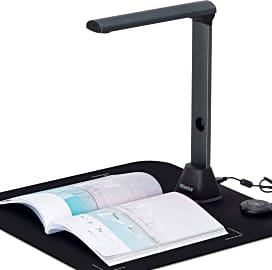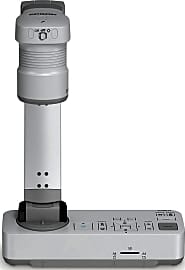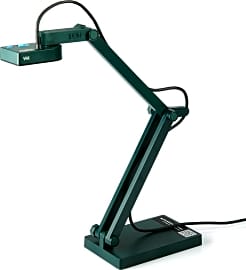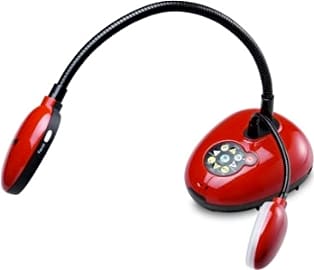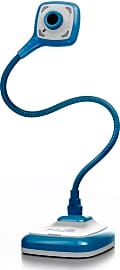The 9 Best Document Cameras

This wiki has been updated 41 times since it was first published in March of 2015. If presentations are a key component of your job — whether in a classroom, training room, boardroom, or even a video conferencing suite — you can incorporate exciting new visual technologies using one of these useful document cameras. These innovative electronic imaging devices can be used to display three-dimensional objects, pages from a book, artwork, people, and more. When users buy our independently chosen editorial selections, we may earn commissions to help fund the Wiki.
Editor's Notes
March 24, 2021:
By the time all was said and done, it wound up being a relatively busy round of updates. Most of our existing choices did still seem to be strong selections, but we wound up removing the Elmo 1351-TTX1 due to availability issues, and even though the Ipevo Point 2 View was still available at the time of this writing, we decided to get ahead of the game and eliminate this discontinued selection, which has now been replaced by the Ipevo V4K Ultra High Definition.
We also added the Ipevo VZ-X to our list, which is similar to the V4K in some ways, but superior in many others — most notably including its Wi-Fi connectivity and built-in battery, which combine to provide it with full wireless functionality. It should be noted, though, that if you want to shoot with the best resolution possible, you need to switch out of its Wi-Fi mode and plug it in.
The Czur ET18 and iOchow S3 both hit our list for the first time, with designs that are quite similar to one another. Both also boast page-flattening technology, which will be a welcome capability for those trying to scan books. However, in spite of their commonalities, we ranked the ET18 higher on our list because it’s compatible with both macOS and Windows, while the S3’s software only runs with Microsoft’s operating system. Other advantages the ET18 presented were supplementary lights to help eliminate shadow and glare, and a slightly better image sensor (18 megapixels compared to 17 megapixels).
We also added the Saiji Gooseneck to the bottom of our list. This option isn’t really a document camera, or a camera at all, but rather a simple bracket attached to a flexible arm that can clamp down on any desk or table that’s up to 2-1/4 inches thick, providing a simple and affordable means of substituting your smartphone for a document camera. It isn’t an especially capable or elegant solution that will appeal to professionals, but for thrifty individuals, students and casual users, it just might do the trick.
Document cameras are a great solution for many situations – like presentations, remote meetings and archiving books – but for other circumstances you might be better off sticking with a scanner.
February 17, 2020:
The new Ipevo V4K Ultra High Definition bested a pair of Ipevo models on our previous list in categories like price and build quality, but it's the 4K resolution that really set it apart. Its Sony-made sensor is no slouch either, coming from a world-renowned imaging company. The Elmo MX-P is another new addition to the market that offers users 4K resolution, and its form factor and well-placed, intuitive controls earned it a top spot.
Elsewhere, we saw the arrival of some upgraded models, including the Lumens DC170 Ladibug and the Elmo 1351 TT-X1, as well as the inclusion of a previously overlooked model, the Epson DC-21 High-Definition. That Epson model may not attain 4K, but its HD video is bolstered by a 12x optical zoom that can combine with a 10x digital zoom to really get you close in on a variety of details. It's also from a company known for making outstanding projectors, so you can safely assume it won't have any connection problems when setting up a classroom.
Special Honors
WolfVision This Austrian outfit offers a nice selection of document cameras that are suitable for a variety of professionals. They also offer other presentation- and communication-related technologies, like projectors. wolfvision.com
AVEr USA With a stated specialization in visual collaboration, this company has more than a dozen document cameras to choose from, including some USB-connected models to work in tandem with your laptop. They offer options with flexible goosenecks, as well as others with hinged mechanical arms. averusa.com
Interactivity On A Large Scale
The camera can also be mounted on a ceiling to capture a wide angle of view, depending on what it is you're trying to present.
Interactivity is a popular theme these days. When you think of interactive information, what comes to mind? Social networking services, for example, allow you to share thoughts with friends, fellow colleagues, and anyone else who's interested in you or a group of people sharing a common interest.
The internet is another prime example of high-tech interactivity at work, given that it connects people to one another through information that one would otherwise not be aware of or would have to research in a library alone. Modern mobile phones connect people not only through voice, but also through built-in digital camera technology that offers the ability to video chat and share experiences and snapshots using a small screen. Camera technology doubles as an interactive teaching tool to distribute knowledge and imagery to large audiences in an academic setting. It is this concept that leads us to the unique niche of the document camera.
Also known as a visual presenter or visualizer, a document camera is a real-time image capture device that has a main purpose of displaying an object to a large audience. The document camera is capable of magnifying and projecting images of both two and three-dimensional objects as well as information on overhead transparencies. Whether you're working in a classroom, video conference room, or even a courtroom, the document camera delivers interactive visual technology in a live presentation to a group of people. Most document cameras are mounted on arms and stands in order for their lenses to be positioned over a page in a book, a piece of artwork, or a three-dimensional object of some kind.
The main components of a document camera include the optics, the camera itself, the lighting system, and the motherboard. The optics define the resulting image quality of whatever is being shown to the audience. The unit's optics make use of an iris (or aperture), which regulates the amount of light passing through its lens.
The smaller the aperture, the greater depth and level of detail that can be shown for an object. Just the same, the greater the light intensity on the document camera, the more independent its operation can be from surrounding light sources. This comes in particularly handy if you intend to make a presentation in a dark room. The motherboard has its greatest influence on the produced image quality. As an object increases in size, it requires a higher degree of image resolution, which means that more data must be processed by the document camera at once. That said, the camera's motherboard must be powerful enough to handle that data.
Unlike an overhead projector, the document camera is capable of zooming in on the object it intends to project to an audience, which allows it to behave like a transparency by enlarging small print or text from a book in real-time. The camera can also be mounted on a ceiling to capture a wide angle of view, depending on what it is you're trying to present. Another fundamental difference with this technology is that document cameras are typically less bulky than their projector counterparts. Such projectors take up a lot of room. The document camera is thinner, lightweight, and easier to adjust. Finally, a document camera does not require dimming of the surrounding light conditions in order to make a presentation easy to see.
Document cameras can be connected to a computer via USB cable or to an interactive whiteboard. Either one of these options provides a method of central collaboration. Central collaboration is a fancy way of saying that a group of presenters (or an audience) can be engaged with a single topic at the same time.
A Brief History Of Document Cameras
The earliest attempts at creating document cameras occurred in the 1970s. These first cameras consisted of conventional video cameras placed onto copy stands with additional lighting added so they could operate in a dark room.
As an answer to the decline in popularity of overhead projectors in the late 1980s and as the need for presenting increasingly elaborate documents to large audiences became more important, both WolfVision and the Elmo Company developed the first document cameras at the same time. The cameras were both displayed at the Photokina trade fair in 1988.
The development and rapid advancements of both digital display and computer technology also helped to drive the adoption of the document camera over traditional projector technology throughout the 1990s into today's presentation market.
The Best Camera To Suit Your Needs
Because document cameras are so versatile in nature with respect to their applications, one must take into account how they plan to use a document camera when making a purchase. If you plan on presentations with extremely large objects, then perhaps a ceiling model with a rotating camera head and multiple output resolutions will be a good choice, since you'll need to move it around quite a bit to get the proper angle.
An on-board adjustable zoom dial is another key feature to look for, as the clarity of your image will greatly depend on an object's size.
By contrast, if your primary need will be for office or classroom presentations, then investing in a smaller desktop model will probably suffice. An on-board adjustable zoom dial is another key feature to look for, as the clarity of your image will greatly depend on an object's size.
Compatibility and connections are also important factors to consider. If using a mix of both Macs and PCs, one must ensure the document camera is compatible with both the Windows and Apple operating systems and that it has a USB connection. Some of the most modern document cameras also have HDMI ports for hooking up to high-definition display monitors.




